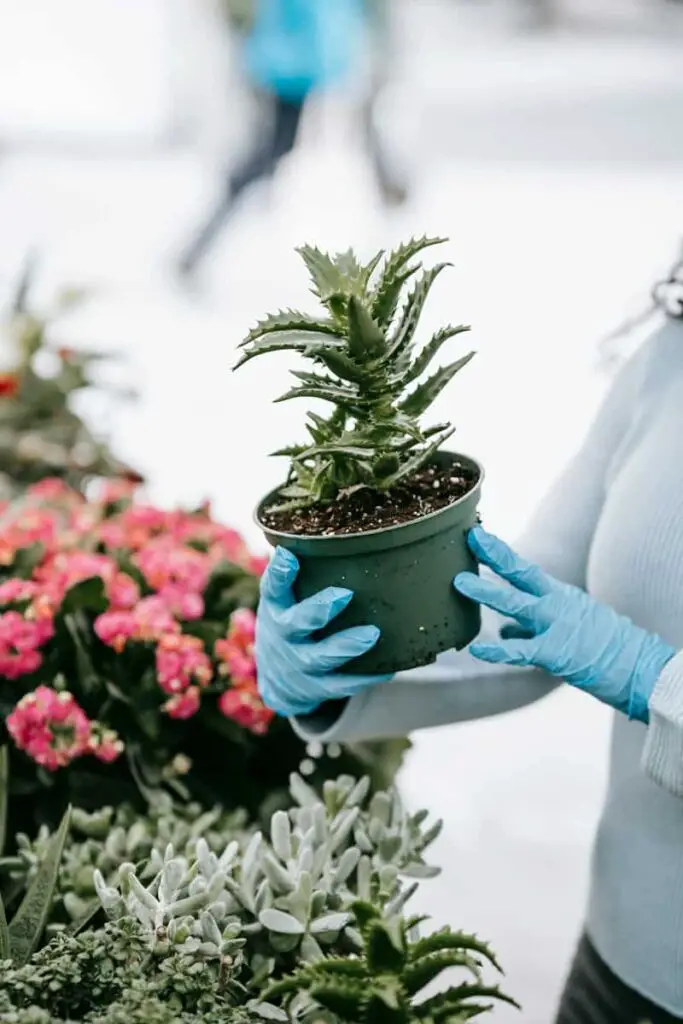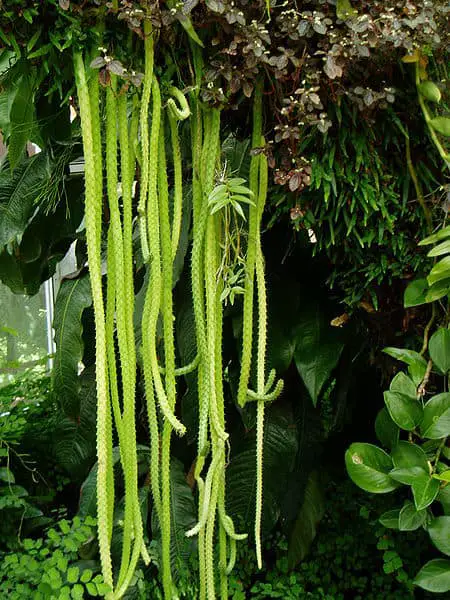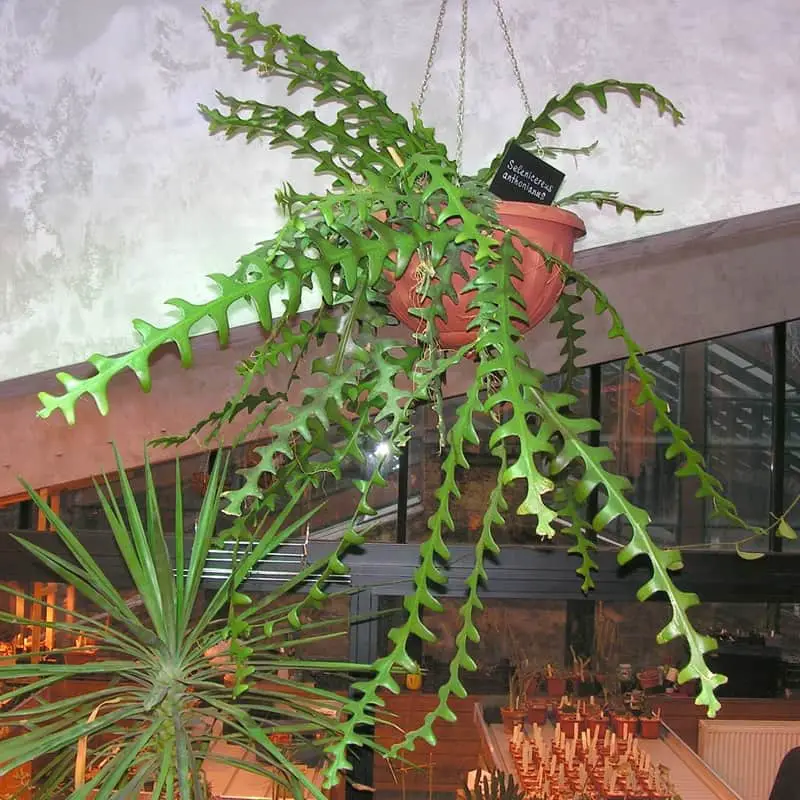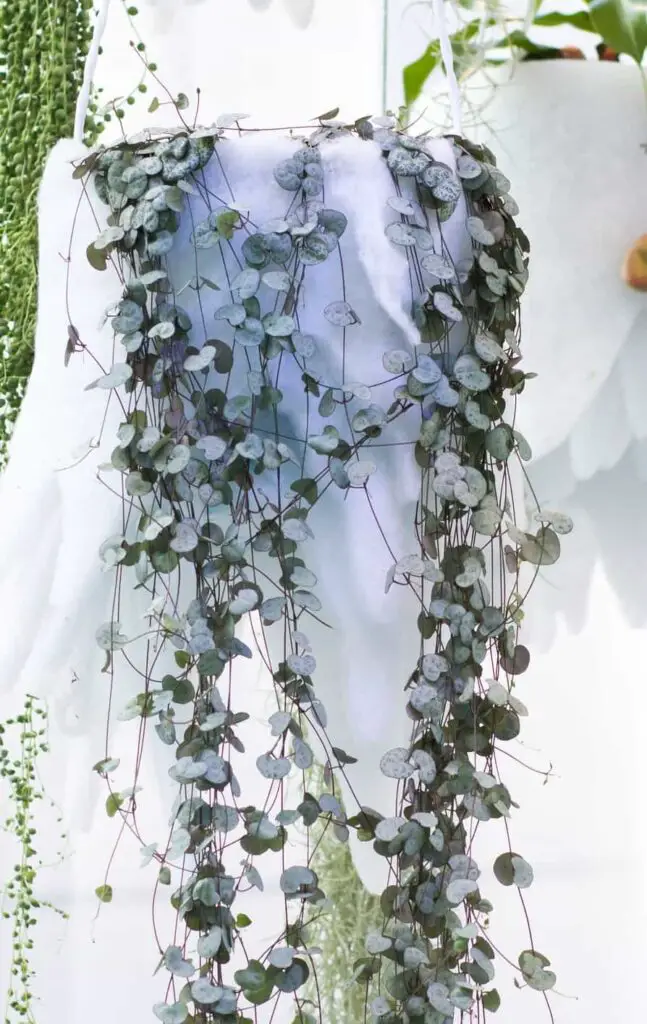Cacti and succulents, are characterized by their unique shapes and their ability to store water in their tissues, have gained popularity due to their ornamental beauty and their adaptability to a wide range of environments.
Thanks to the diversity of species that make up cacti and succulents, it’s easy to find a plant that suits you.
So, if you want to have a hanging garden, don’t worry, you can find a trailing succulent to decorate your garden.
Hanging cacti and succulents represent a fascinating and increasingly popular category of ornamental plants that add a distinctive and incredible touch to any space.
With their variety of shapes, textures, and colors, these species not only contribute to aesthetic beauty but also showcase remarkable adaptability to various environments, from hanging gardens to sunny interiors.
Which is why here I share 10 Cactus and Succulents that Hang Down you will love.
1. Senecio rowleyanus

Senecio rowleyanus, commonly known as “String of Pearls,” is a succulent plant distinguished by its unique characteristics.
This plant features delicate, trailing stems that can reach considerably long lengths, adorned with rounded, succulent leaves arranged in the form of translucent pearls.
Each of these leaves, with a vibrant green color, stores water, which gives the plant remarkable drought resistance.
The flowers of Senecio rowleyanus are small and white, often appearing in summer, although its main attraction lies in its leaf structure, reminiscent of an elegant string of pearls.
This succulent is a popular choice for both indoor and outdoor settings in warm climates, where its distinctive appearance and ease of care make it a charming addition to any plant collection.
2. Rhipsalis sp

Rhipsalis sp, belonging to the cactus family, is a fascinating genus of succulent plants distinguished by their unique and adaptable appearance.
These epiphytic succulents feature slender, hanging stems, often branching, which can reach variable lengths depending on the species.
Its stems are segmented and generally lack spines, giving them a smooth and elegant appearance.
The leaves (if present) are small and generally inconspicuous, as the plant primarily focuses on the development of its stems and its ability to store water in challenging environmental conditions.
During the flowering season, Rhipsalis spp. produces small white, yellow, or pink flowers that add additional charm to its exotic and natural appearance.
These plants are ideal for hanging baskets, elevated pots, or as part of vertical gardens, creating a unique and attractive visual effect both indoors and outdoors.
Their adaptability and low maintenance make them a popular choice for those looking to add a touch of exotic greenery that is easy to care for to their environment.
You may like: 11 Plants That Don’t Need Drainage Holes
3. Aloe juvenna

Aloe juvenna is a species of succulent plant known for its distinctive features and easy maintenance. This succulent forms compact rosettes of fleshy, triangular leaves that arise on short, erect stems.
The leaves are adorned with small white bumps along the margins and on the surface, giving it a distinctive appearance of white spines.
Its intense green color with white spots and its closed margins contribute to its ornamental appeal.
As the plant matures, it can produce clusters of bright orange tubular flowers on thin stems that emerge from the center of the rosette.
Aloe juvenna is an easy-care and resilient plant, making it an excellent choice for beginner gardeners and those looking to add a touch of exoticism and natural beauty to their indoor or outdoor spaces.
4. Sedum morganianum

Sedum morganianum, commonly known as “Burro’s Tail,” is a charming and peculiar-looking succulent plant that stands out for its distinctive characteristics. Originating from Mexico, this succulent forms long, trailing stems densely covered with fleshy, cylindrical leaves resembling beads or bubbles arranged along the stems, creating a unique visual effect.
The leaves, which are of a grayish-green or bluish-green color, are thick and fleshy, adapted to retain water in arid conditions. During the summer, Sedum morganianum can produce small, star-shaped flowers in pale pink or white clusters at terminal ends, although it’s the succulent leaves that are the main attraction of this plant.
Sedum morganianum is a popular choice for hanging baskets and elevated pots, both in sunny indoor settings and outdoor gardens, thanks to its easy care and its ability to add an exotic and cheerful touch to any green space.
5. Disocactus flagelliformis

Disocactus flagelliformis, commonly known as “Cactus Rat Tail,” is a species of epiphytic cactus that captivates with its uniqueness and delicacy. Originating from Mexico and Central America, this cactus develops long, slender stems that elegantly hang, adorned with tiny, practically invisible spines of bright green color.
Along the stems, striking funnel-shaped flowers develop, which can be pink, red, or white, adding vibrant contrast to the plant’s greenery. The flowers typically appear in spring and summer, attracting pollinators with their delicate fragrance and attractive coloration.
The hanging and ornamental nature of Disocactus flagelliformis makes it a popular choice for hanging baskets and elevated pots, where its long, flowing stems can display their natural grace, transforming any space into an oasis of exotic beauty and botanical serenity.
6. Epiphyllum spp

The hanging and ornamental nature of Disocactus flagelliformis makes it a popular choice for hanging baskets and elevated pots, where its long, flowing stems can display their natural grace, transforming any space into an oasis of exotic beauty and botanical serenity.
The flowers of Epiphyllum spp. are one of their most striking features, appearing in a wide range of vibrant colors, including white, pink, red, orange, and yellow, emitting a sweet and intoxicating fragrance during the night to attract pollinators.
The flowers are usually large and showy, shaped like funnels or trumpets, and may last only a few days.
The ornamental beauty of Epiphyllum spp., combined with its relative ease of care, makes it a popular choice for amateur gardeners and plant collectors looking to add a touch of exoticism and elegance to their gardens or interiors.
7. Hatiora salicornioides

Hatiora salicornioides is a succulent plant that draws attention for its peculiar appearance and natural elegance. Originating from Brazil, this cactus features hanging, segmented stems that resemble long chains or tangled snakes.
Its stems are of an intense green and are composed of cylindrical segments that grow spirally.
Along the stems, Hatiora salicornioides produces small and delicate areoles from which tiny spines emerge, giving it a smooth texture and an attractive appearance.
During spring, the plant can surprise with a display of bright orange or pale yellow flowers adorning the ends of the stems, adding an additional touch of beauty and charm.
This plant is an ideal choice for hanging baskets or elevated pots, where its hanging stems can unfold their natural grace, creating a serene and harmonious atmosphere in any space.
8. Selenicereus anthonyanus

Selenicereus anthonyanus is a succulent plant that captivates with its unique appearance and exotic charm. Native to Mexico and Central America, this species is distinguished by its flattened, segmented stems, which branch out to form a hanging or climbing structure.
The leaves are dark green and adorned with wart-like protrusions along the edges.
During the flowering season, Selenicereus anthonyanus produces spectacular nocturnal flowers, large in size and fragrance, which open only at night to attract pollinators.
These flowers can be white or cream in color, with long, slender petals that add a touch of elegance to the plant.
The combination of its distinctive leaves and fascinating flowers makes Selenicereus anthonyanus a popular choice for those seeking a unique and eye-catching succulent to add to their collection of indoor or outdoor plants.
9. Epiphyllum anguliger

Epiphyllum anguliger is a species of epiphytic cactus that surprises with its unique appearance and natural elegance.
Native to Mexico and Central America, this cactus develops flat, segmented stems that grow in a hanging or climbing manner, with serrated edges resembling fish fins or fern leaves.
The leaves, dark green and succulent, provide ornamental appeal even when the plant is not in bloom.
During the flowering season, Epiphyllum anguliger produces white flowers that emit a sweet and intoxicating fragrance at night to attract nocturnal pollinators.
The hanging and ornamental nature of Epiphyllum anguliger makes it a popular choice for hanging baskets, elevated pots, or for adorning walls and pergolas, where its unique beauty can shine and captivate onlookers.
10. Ceropegia woodii

Ceropegia woodii, commonly known as “Chain of Hearts,” is a succulent plant distinguished by its elegance and delicate charm.
Native to South Africa, this species features long, slender stems that grow in a trailing manner, adorned with bright green, heart-shaped leaves with silver patterns and edges in purple tones.
Each stem is adorned with a series of small leaves that create a chain-like appearance, earning it the common name “Chain of Hearts.” Ceropegia woodii produces small, bell-shaped flowers in white or pink that often emit a soft vanilla fragrance.
This plant is highly valued for its decorative appearance and ease of care, making it a popular choice for hanging baskets, elevated pots, or as an indoor plant.
Its trailing nature and ability to thrive in moderate light conditions make it an ideal choice for those looking to add a touch of elegance and serenity to their green space.
In conclusion, hanging cacti and succulents are ideal for your garden, as they are not only beautiful plants but also easy to care for and don’t die as easily.
The ability of these plants to thrive in a variety of environments, both indoors and outdoors, makes them a popular choice for those who lack experience with plants or feel unsure about how to care for them.
So, dare to have your hanging garden in your outdoor space or inside your home.
